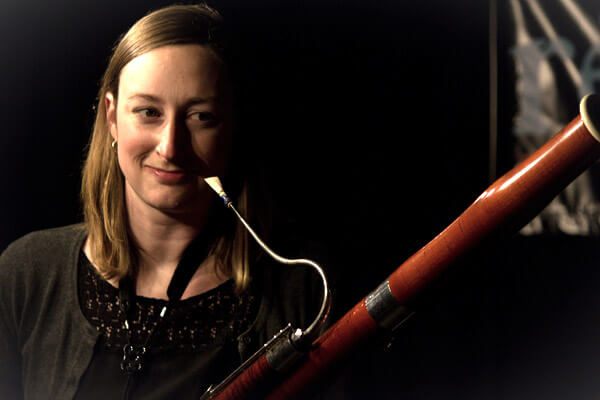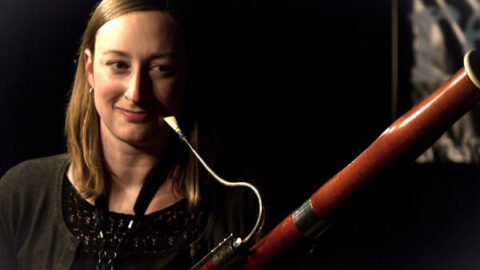In true modern musical artist fashion, Dana Jessen has her fingers and her feet planted in multiple roles and realms. Her new recording of Michael Gordon’s Rushes, performed with the Rushes Ensemble of seven bassoonists, is released on Cantaloupe Music today, March 25, 2014. Dana has recently relocated to Oberlin, which gave us the opportunity to sit down with her and talk about Rushes and her ongoing projects.

How was the Rushes project with Michael Gordon conceived and brought to reality?
The idea started in 2009 when I arranged Michael’s The Low Quartet, in its version scored for low-sounding solo instrument with three pre-recorded parts, for a solo program of contemporary bassoon music. Until recently, the bassoon hasn’t had a strong presence in new music and I’ve often found myself battling the Grandfather stereotype, from Peter and the Wolf, that many still associate with my instrument. We have notable works like Berio’s Sequenza XII, but the amount of contemporary bassoon repertoire pales in comparison with what exists for percussion, piano, strings, or even other wind instruments. When I finished the bassoon arrangement of The Low Quartet, I emailed it to Michael to tell him of my plans to perform it. He responded enthusiastically and said that he really enjoyed the sound of multiple bassoons. Shortly after, I approached Michael about writing a large-scale work for bassoon and that I would organize a consortium of bassoonists to fund the commission. He was thrilled with the idea and we set to work on it. Soon Michael’s concept began to unfold and the piece evolved into an hour-long composition for seven bassoons. We met several times to discuss ideas and play through sketches. At one point I brought five bassoonists to his living room so that he could hear the sonorities produced by multiple players. Once the final version was completed, I organized the Rushes Ensemble, a phenomenal group of bassoonists from all over the US: Saxton Rose, Rachael Elliott, Jeffrey Lyman, Lynn Hileman, Maya Stone, and Michael Harley. We worked closely with Michael to finalize the piece and recorded Rushes at the Experimental Media and Performing Arts Center in New York. Collaborating with composers is one of my favorite aspects of new music and my experience working with Michael has been hugely rewarding.
What is the music like, what demands does it place on the players, and what rewards should it provide the listener?
My first impression of the piece was that it looked like a percussion score; there are no obvious melodic or lyrical lines commonly found in wind music. Instead, we play continuous articulated patterns that lengthen and shorten over its duration. Michael was particularly drawn to the articulated attacks of multiple bassoons in counterpoint with each other and the piece reflects this. Patterns are made collectively by the bassoonists with subtle changes emerging from player to player to create a cascading effect. The continuous shifting patterns and dynamics give the impression that the sound is traveling. This architectural movement of sound is a technique that Michael developed in his percussion sextet, Timber. The cascading effect is even more apparent when we perform in a circle with the audience surrounding us. The audience experiences the circular movement of sound as it slows down, speeds up, and changes direction. For the players, endurance is the biggest challenge. Sixty minutes of continuous articulated patterns can be very taxing.. The result is well worth the effort, as Rushes is unlike anything else ever written for the bassoon. I encourage listeners to close their eyes during the performance and live in this beautiful reedy mass and rich overtones that will fill their ears. I’m very excited for the world to experience Rushes– it is truly a mesmerizing work.
What can you tell us about your recently-formed ensemble, Splinter Reeds, and your other ongoing projects?
Splinter Reeds is an exciting new reed quintet based in the Bay Area. The reed quintet is an emerging genre of chamber music that includes oboe, saxophone, bassoon, clarinet and bass clarinet. It is an evolutionary detour from the traditional woodwind quintet with the advantage of a more closely related instrumental family. Ever since I worked with the Calefax Quintet when I lived in Amsterdam, I’ve wanted to start my own reed quintet with a focus on new music. When I lived in the Bay Area I knew several wind players from the San Francisco Contemporary Music Players and we got together to form Splinter Reeds. We have several exciting projects coming up with new works by Marc Mellits, Erik DeLuca, Dan VanHassel, and Aaron Novik, among others. In addition to Splinter Reeds, I am working on a solo bassoon and electronics program featuring new works by Paula Matthusen, Sam Pluta, Peter V. Swendsen, and Tristan Perich. I’m super excited to work with these four amazing composers and will be premiering the program towards the end of 2014 with plans to record the project in 2015.

You’re also an avid improviser. How does that fit into your artistic life and how do you see that evolving?
I became serious about improvised music when I was a graduate student at the New England Conservatory. I remember seeing a handful of incredibly moving performances by guest artists and students which conveyed a raw emotion and powerful expression that I had yet to experience from classical musicians. Both the audience and musicians were always on the brink of the unknown. There is a freedom and an edge to improvised music that is really attractive to me, music for the people. Steve Lacy was quoted saying that improvisation is a matter of life and death. I always try to approach improvisation on these terms, with a sense of urgency and emotion. I really began blossoming as an improviser when I lived in Amsterdam. One of the reasons I stayed there for three years was to continue my research in improvised music. A few teachers who have been influential in helping me to shape my identity as an improviser are Frank Gratkowski, Wilbert de Joode, Wolter Wierbos, Michiel Braam, Joe Maneri, Anthony Coleman, and Joe Morris. Improvisation continues to be a huge part of my artistic identity, as I truly believe in the fluidity of composition, improvisation, and interpretation.
What do you see as the shifting demands on the musical artist who is determined to make a career of their art in the changing commercial landscape.
Entrepreneurship is a concept that should go hand-in-hand with being a musician. It is so important for musicians to understand how art is funded in the US and in other countries. Grants, sponsorship, crowd-funding, donor support, these are the essence of the new business model for musicians. We must find a way to tap into these sources. For me, entrepreneurship is a necessity if I want to continue playing the music that I am most passionate about. Please let me know if you ever see a job opening for a bassoonist specializing in contemporary and improvised music! I do not want to change what I am as an artist just to get paid. To succeed, I have to create my own opportunities and find people who are interested in my work. Many students want to focus on playing well and being the best at their instrument. While this is helpful, being the best entrepreneur is even more valuable.
Upcoming Rushes CD release events:
March 26, 2014 at 8:00 PM (Free Concert), Distler Performance Hall, Granoff Music Center, Boston, MA
March 28, 2014 at 8:00 PM, The Icebox at Crane Arts Center, Philadelphia, PA
March 29, 2014 at 8:00 PM, Peak Performances at Montclair State University, Montclair, NJ
























